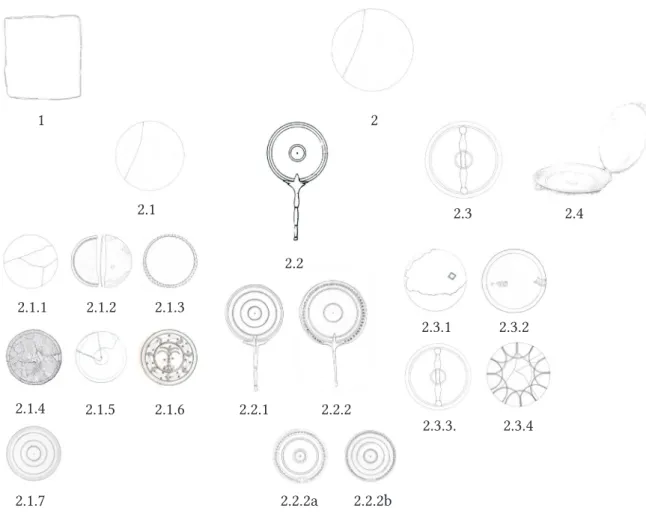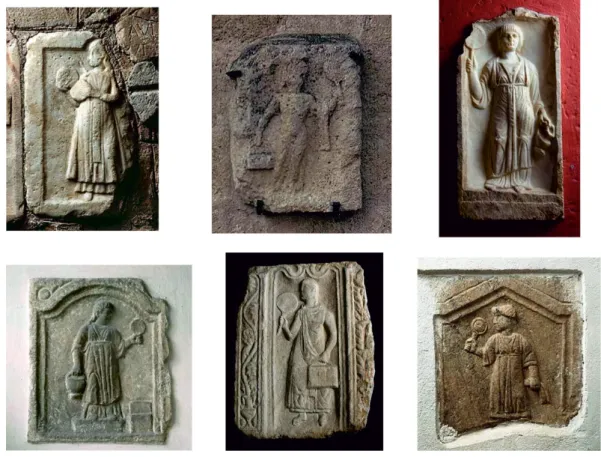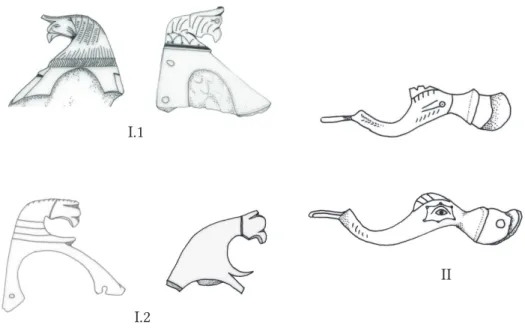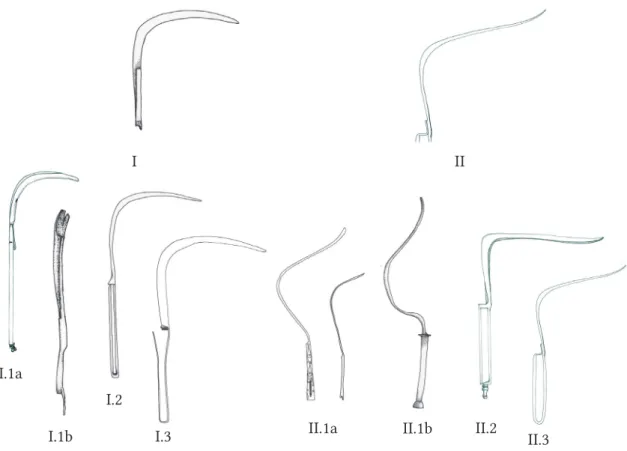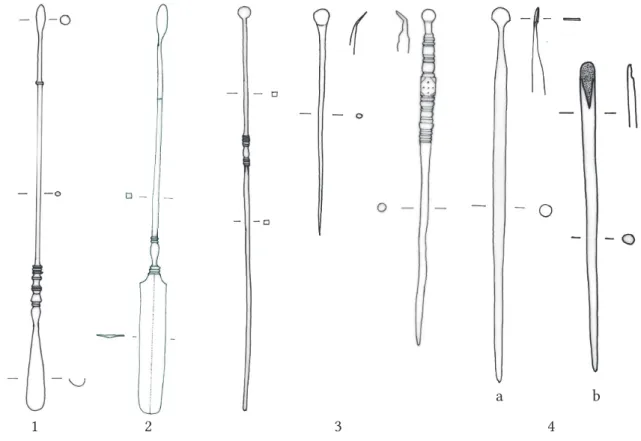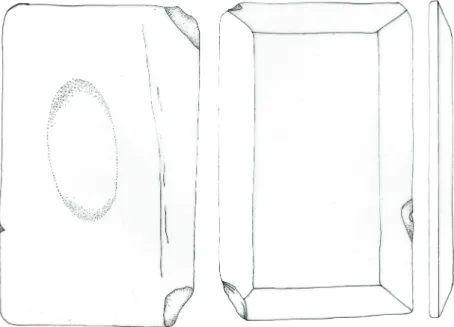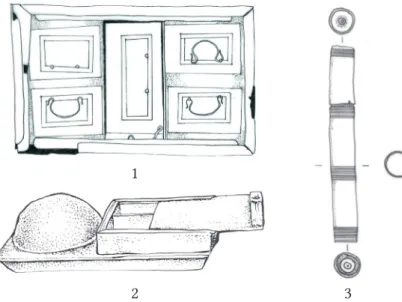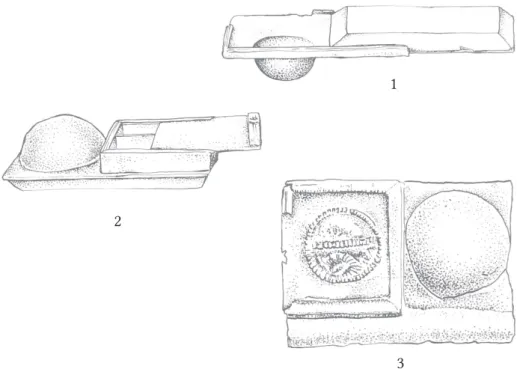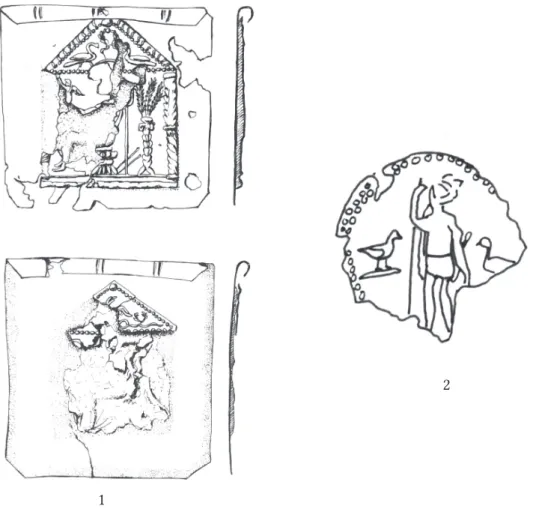Dissertationes Archaeologicae
ex Instituto Archaeologico
Universitatis de Rolando Eötvös nominatae Ser. 3. No. 5.
Budapest 2017
Dissertationes Archaeologicae ex Instituto Archaeologico Universitatis de Rolando Eötvös nominatae
Ser. 3. No. 5.
Editor-in-chief:
Dávid Bartus Editorial board:
László Bartosiewicz László Borhy Zoltán Czajlik
István Feld Gábor Kalla
Pál Raczky Miklós Szabó Tivadar Vida Technical editors:
Gábor Váczi Dávid Bartus
Proofreading:
Szilvia Szöllősi Zsófia Kondé
Available online at http://dissarch.elte.hu Contact: dissarch@btk.elte.hu
© Eötvös Loránd University, Institute of Archaeological Sciences
Budapest 2017
Contents
Articles
András Füzesi – Norbert Faragó – Pál Raczky 7
Tiszaug-Railway-station. An archaic Middle Neolithic community on the Great Hungarian Plain
Zsuzsanna Siklósi – Zsuzsanna M. Virág – Viktória Mozgai – Bernadett Bajnóczi 67 The spread of the products and technology of metallurgy in the Carpathian Basin
between 5000 and 3000 BC – Current questions
Attila Király 83
Grd-i Tle knapped and ground stone artefacts, excavation seasons 2016–2017
Tamás Dezső 97
The arrowheads from Grd-i Tle (Rania Plain, Iraqi Kurdistan)
Bence Soós 113
Early Iron Age burials from Tihany, Hungary
Abdullah Bakr Othman 207
The Middle Assyrian Ceramics at Sheikhi Choli Tomb
Katalin Vandlik 241
Le renard dans les fables antiques et ses représentations
Lajos Juhász 251
Burning money – a coin hoard from Brigetio
Bence Simon 259
Physical landscape and settlement pattern dynamics around Aquincum and Carnuntum – A socio-economic approach
Anna Herbst – Ágnes Kolláth – Gábor Tomka 287
Beneath the Marketplaces. Árpádian Age (10th–13th century) settlement traces from the city centres of Pápa and Győr, Western Hungary
Field Reports
Zoltán Czajlik – Saša Kovačević – Georg Tiefengraber et al. 343 Report on magnetometer geophysical surveys conducted in Hungary, Austria and Croatia in the framework of the Interreg Iron Age Danube project
Tamás Dezső – Gábor Kalla – Barzan Baiz Ismail et al. 361 Preliminary Report on the Hungarian Archaeological Mission (Eötvös Loránd University) at Grd-i Tle (Saruchawa) in Iraq. Second Season (2017)
Márton Szilágyi – Kristóf Fülöp – Eszter Rákos – Nóra Szabó 393 Rescue excavations in the vicinity of Cserkeszőlő (Jász-Nagykun-Szolnok county, Hungary) in 2017
Dóra Hegyi – Gergely Szoboszlay 401
Short report on the excavations in the Castle of Sátoraljaújhely in 2017
Thesis Abstracts
András Rajna 413
Changes in Copper Age Networks of Connections in Light of the Material Excavated in the Danube-Tisza Interfluve
Anikó Bózsa 423
Instruments of beauty care from the Hungarian part of Pannonia
Zsolt Körösfői 439
Die Marosszentanna-Kultur in Siebenbürgen
DissArch Ser. 3. No. 5. (2017) 423–438. DOI: 10.17204/dissarch.2017.423
Instruments of beauty care from the Hungarian part of Pannonia
Anikó Bózsa
Ferenczy Museum Center bozsa.aniko@muzeumicentrum.hu
Abstract
Abstract of PhD thesis submitted in 2017 to the Archaeology Doctoral Programme, Doctoral School of History, Eötvös Loránd University, Budapest, under the supervision of László Borhy.
Roman beauty care can be examined through several sources. Among the written sources we can differentiate between direct and indirect sources. The former type includes pieces of edu- cative literature on cosmetology or giving advice on how to care for the body. Some of them report the expectations for men and women, give detailed descriptions about beauty care customs or about cosmetics used on various parts of the body. Others describe the materials, where these were imported from or their effectivity etc., as well as the process of making of these and their use. There are less direct sources than indirect ones. Indirect sources have other aims; for example medical or scientific writings, which only slightly touch the topic of Roman beauty care, but give considerable information about the use of instruments, especial- ly in the case of those with a double function, or raw materials. For example in the chapters about plants and minerals of Pliny’s Naturalis Historia the author never fails to mention the applications of the discussed material in cosmetology. The larger part of the sources are pieces of literature in which the author wishes to emphasize a character’s features – generally neg- ative, not positive –, mentioning the excessive use of beauty care rituals or on the contrary, their total absence. Also, there are philosophical and rhetorical reports in which celebrated or condemned beauty care customs appear like symptoms of the ethical condition of a society.
The picture outlined by the literary sources hints on the beauty care rituals, the materials used, as well as their trade. However we need to emphasize that this picture is limited from both territorial, temporal and social aspects. The sources originate mainly from the period of the later Republican Age to the end of the 1st century AD and deal only with personalities (and their customs) in high social status living in the City of Rome or Italy at the most. We do not know how this definite picture about beauty care rituals in the Roman Age changed in the later phases of the Roman Empire, how it was affected by the ethnic or territorial specialties or in what form did it reach the lower social strata. Archaeological finds can help us to find the answer to these questions.
Not only the artefacts but also the epigraphic and pictorial sources belong to the category of archaeological finds. The importance of the epigraphic sources is that they define the public places of body care, for example baths and barbershops, and contain the names of profession- als participating in these actions. The pictorial sources are various: reliefs on tombstones, wall paintings, sculptures, mosaics which show the objects, and the way they were used. This can be compared with the repertoire of the archaeological finds.
424
Anikó Bózsa
Roman beauty care
The description we get from written and pictorial sources about Roman beauty care is as follows.
Both sexes used a lot of scents and cosmetics to care for their hair, body and face or to make themselves sweet-scented. Women hydrated their skin, tried to eliminate skin blemishes and fought against wrinkles. The depilated skin was a basic assumption of the well-groomed ap- pearance, Romans depilated with wax, a bruise-stone or a razor, but other materials also exist- ed which promised permanent hairlessness. We cannot check the effectivity of these now, but presumably their use was rather motivated by superstitious concepts, nor real effects. Romans dyed their hair, not only because of greying, but it was in fashion. Especially red hair was very fashionable in the Early Empire. To make the complicated coiffures inspired by the empresses women used curling-irons; to keep the appropriate condition of the hair they needed various unguents. The use of these could damage the hair quite badly, causing serious loss of hair. As a solution wigs were worn. To hide blemishes or to emphasize the advantageous face parts they used make-up or beauty-plasters. According to the literary sources the basis of Roman make-up was the flawless white skin. The cheeks were painted in rose, the eyes contoured, the eyelashes and the eyebrow painted with black mascara. Roman men were shaved from the Republican Era. They did not wear a beard except for a few examples until wearing a beard became fashionable from the time of Hadrians’ reign. They were depilated on the arms and in the armpits, however the hairlessness of the legs was considered to be an exaggeration. They cared for their hairdo, if they became bald they wore a wig. They cut their nails regularly, and removed the hair growing from the nose. They did not refrain from using make-up, but they could easily make themselves ridiculous if they overdid it. Both sexes were cautious about their dental care, tried replacing missing teeth. The bad blow or body odour was considered to be a very serious neglect of personal hygiene, therefore they washed themselves regularly or tried to gloss over the odours with perfumes.
The feminine beauty ideal of the Roman Age was the gracile but well-set woman with modest breasts. In order to resembe this ideal, women followed a diet and wore a kind of bra. The pictorial sources retained the Romans’ attitude to the nude female body which was healthy and devoid of any prudery.
Artefacts
The repertoire of objects related to beauty care includes well defined and characteristic ob- jects. They appear in the whole territory of the Roman Empire from the end of the Repub- lican Age. This chronological border indicates that these objects became characteristic and uniformed at this point, and in their evolved form they are easily recognizable. They can be considered one of the markers of Roman presence or the process of romanisation from this time on, and came into general use. The function of some of them as cosmetic tools can be clearly defined: mirrors, combs, razors, strigils, nail-files and cosmetic sets. Others are devic- es with multiple functions, which can be used not only in beauty care, but surgery, painting or in other domestic activities. These are the spoons (canonic forms are the spoon and the spatula probes and the earspoons), the forceps, palettes and various types of small storage boxes. The examination of their find circumstances and accompanying finds can help us to ascertain their accurate function. Closed find groups like tombs, finds from towns destroyed
425 Instruments of beauty care from the Hungarian part of Pannonia
by the Vesuvius, as well as the rare deposited or in situ find groups give us the possibility of examination. If we find one of these objects with undetermined function beside a certainly surgical or medical tool, the whole find assemblage can be defined as a surgical/medical set.
However if the group does not contain such an object, a single instrument found in a medical set cannot define the clear medical function of the other instruments in the assemblage. The absence of these objects indicates that the set be defined more likely as a cosmetic set. This is also true in case we find mirrors, combs, razors, strigils beside a multifunctional tool. It is however important to stress that the interpretations are adventitious in all cases and apply only to a certain find assemblage, the exact role of a multifunctions tool can be different de- pending on the find circumstances.
In previous papers dealing with tools of beauty care we can find clear-cut terms and explicit definitions of function in almost every case. However, a critical approach to these is very im- portant as these names and functions are conclusions derived from the context of frequently used tools’ names, as well as their occurrence in antique Greek and Roman medical sources or identifications based on theoretical similarities.
The tools which we can define as equipment related to beauty care are the following: mirrors, combs, razors, tooth cleaners, strigils, cosmetic sets, forceps, palettes, spoons, spoon probes, spatula probes, ear probes, boxes, jars, balsamariums.
Instruments of beauty care from the Hungarian part of Pannonia
The mirrors found in the Hungarian part of Pannonia follow the general mirror forms known from other Roman provinces. According to the typology based on the form of the objects, we can separate two main groups: the round (Fig. 1, Type 1.) and the rectangular mirrors (Fig. 1, type 2.). Three subtypes belong to the latter group: mirrors without handle (Fig. 1. 2.1), hand mirrors (Fig. 1.2.2–3) and lid mirrors (Fig. 1. 2.4). There are two types of mirror handles: the vertical one (Fig. 1. 2.2) and the loop handle that runs across the back of the mirror and its form resembles the handle of a pot (Fig. 1. 2.3). The vertical handle is a quite standardized form, while the latter can be varied but the number of finds in this group is much lower than the vertical ones. The most common mirror form in both Pannonia and other provinces is the hand mirror with a border of holes, decorated with lathe-turned concentric circles, with bal- uster type grip handle (Fig. 1. 2.2.2). Mirrors appear in the province with the Roman conquest, at first in find circumstances what can be dated to the Flavian age, and are very common finds in early cremation burials. The more representative, specific forms such as hand mirrors with a border of holes or a simpler variant decorated only with lathe-turned concentric circles (Fig. 1. 2.2.1), as well as the rectangular mirrors appear in the find assemblages until the end of the 2nd century AD. From this time on a massive decrease can be noticed in the number of mirrors found in datable find contexts, while forms become less schematic such as mirrors with incised geometric decoration (Fig. 1. 2.1.6), or with a loop handle.
The find circumstances of the mirrors in Pannonia do not add to our comprehension of the possible symbolic meaning of mirrors in sepulchral circumstances, beside the obvious role of female attribute or a tool for representation. Although the role of the mirror as an interme- diary between the two worlds - ours and the other world - is clear from the mirrors used as instruments of divination in Greek antiquity or from their representations on Greek funerary
426
Anikó Bózsa
vase paintings, this aspect is not traceable in the Roman culture. The examination of the very specific tombstone type with mirror representations in Pannonia and Noricum is important from this point of view (Fig. 2). The mirrors do not appear in the way they are normally used but either held over the head, or in equal height with the head and turned in the direction of the viewer, or also somewhat lower in front of the body and depicted larger-than-life. The figure holding the mirror is interpreted to be Camilla, a servant making an offer, who appears on some representations in a setting referring to a burial-feast ceremony. Since all objects which appear in this context have a special function, we can assume the same for mirrors, however we cannot verify this at the moment. The unrealistic way the object is held, as well as its emphasized representation confirms this.
There are two easily distinguishable horizons of Roman combs: the early and the late variants.
The two groups can be separated not only according to the date when they were buried in the ground but also their design. The earliest combs from the early phase of the Roman Empire are simple and uniform. While the material from the settlements destroyed by the Vesuvius imply more variability, the dominant form of early combs in the provinces, among them Pan- nonia, is the double-sided comb from one piece of bone or wood (Fig. 3, Type I). These usually come from early cremation burials and this circumstance explains why the number of the ear- ly combs is very low compared to the amount of the later composite comb variations. There are some particular pieces, like the comb fragment of Indian origin with relief decoration from Gorsium, or the one from Aquincum decorated with letters in opus interrasile technique.
Fig. 1. Typology of roman mirrors from Pannonia.
1 2
2.1
2.1.1 2.1.2 2.1.3
2.1.4 2.1.5 2.1.6
2.1.7
2.2
2.2.1 2.2.2
2.2.2a 2.2.2b
2.3
2.3.1 2.3.2
2.3.3. 2.3.4 2.4
427 Instruments of beauty care from the Hungarian part of Pannonia
The other comb type is the composite comb which appears from 360 AD in burials in Pannonia (Fig 4, Type II). The variability of forms among these is higher. We can separate groups by the method of fabrication or the handle-forms. The double-sided composite combs come in the largest number. These differ from the early variants by an additional handle-band which allows to make the comb from more than one pieces and gives place for the decoration (Fig. 4. II.2).
The other group of the composite combs has one side (Fig. 4. II.1). We can separate one-sided combs composed of three (Fig. 4. II.1.1) or five pieces (Fig. 4. II.1.2). On the latter there are two more additional handle-bands apart from the two handle plates and the middle plate with teeth.
The handle-forms are various, there are variants in half-oval (Fig. 4. II.1.1.1a), ovoid (Fig. 4.
II.1.1.1b), bell-shaped (Fig. 4. II.1.1.1c), semi-circle (Fig. 4. II.1.1d) triangle with round-cornered edges form (Fig 4. II.1.1.1e) and triangle (Fig. 4. II.1.1.2). The combs made of five pieces are very specific. They are decorated with characteristic techniques, and zoomorph images can be ob- Fig. 2. The so-called Camilla reliefs from Pannonia and Noricum (ubi_erat_lupa.org).
Fig. 3. The earlier-I. type of combs from Pannonia.
428
Anikó Bózsa
served on some of them. The barbarian impact on late Roman composite combs is frequently discussed. It is traceable on the one-sided combs with arched handles or on the combs made of five pieces. The best parallels and analogues of the decoration or forms of the combs can be Fig. 4. Composite comb types from Pannonia.
II.1 II.2
II.1.1 II.1.2
II.1.1.1 II.1.1.2 II.1.2.1
II.1.2.2.1
II.1.1.1a II.1.1.1b
II.1.1.1c II.1.1.1d
II.1.1.1e
429 Instruments of beauty care from the Hungarian part of Pannonia
found in the cemeteries of the Sântana de Mureş-Černjachov culture. The comb forms in the material heritage of the barbarian tribes living north-west from the border of the Roman Em- pire are almost indifferent from the point of view of the development of the Pannonian comb variations. The exception is the one sided composite comb with triangle handle.
There is no consensus about the Roman razor forms and types in the research. From the types included in the typology of J. Garbsch only razors with wide, round-cornered blades (Type B, Fig. 5, Group I) and with wide, four-squared blade (Type C, Fig. 5, Group II)1 were found in Pan- nonia until now. The interpretation of the other variant with a narrow knife-like blade (Type A) is insecure, G. C. Boon classifies it more likely as a cosmetic knife than a razor.2 Usually only the bronze handle of the razor blades remains in Pannonia, one group of these is in form of an animal head, such as a stylized large cats’ or griffin’s head (Fig. 5. I.1) and there is another variation which imitates these (Fig. 5. I.2). The repertoire of forms of this razor type is very unified in the Roman territory. We know the find circumstances only in a very few cases, these are from contexts which date from the second half of the 2nd century AD until the first half of the 3rd century AD, but pieces are known also from the 4th century AD. In the case of razor handles included in the thesis find contexts are unknown. The two dolphin razors with wide, four-squared blade were buried in the first half of the 3rd century AD according to the stylistic criteria of the typochronology of J. Garbsch (based on the arch of the body of the dolphin).
The interpretation of objects defined as teeth cleaners is also insecure. The tools with small, plain, leaf-like spatula with bended, pointed ends are often interpreted as surgical tools, but the definition of M. Martin based on the elaborate examination of the material is much more convincing.3 According to this these objects are teeth cleaners. The presence of the form in double-sided tools like the filtering spoon/teeth cleaner or in sets with specifically eating purpose, as well as the absence of the from in sets of surgical instruments makes the inter- pretation of these objects as surgical tools very insecure.
1 Garbsch 1975.
2 Boon 1991, 22–24.
3 Martin 1984, 122–129.
I.1
I.2
II
Fig. 5. The two known roman razor types from Pannonia.
430
Anikó Bózsa
Two spoon forms can be observed on Roman strigils which emerged until the 1st century BC. These two forms are the ba- sic criteria of the strigils’ typology and chronology.4 The linear, short, rectangular ligula form (Fig. 7, Type I.) appeared from the beginning of the 1st century BC, while the other, longer, s-shaped spoon (Fig. 7, Type II.) appeared from the end of the 1st century BC in the find material. Both are known from the territory re- searched in this thesis and appear with three types of handles.
The three handle types differ both in form and manufacturing technique. The plain, band-formed handles are casted separate from the ligula (Fig. 7. I.1). The double, box-shaped handles can be produced by casting, separated from the spoon or together with the ligula, in which case the handle is formed with the elonga- tion and inflexion of the spoon (Fig. 7. I.2, I.3, II.2, II.3). There is a correspondence between the spoon and handle forms, the ligu- la form can be a chronological indicator. The plain, band-formed handles only associate with linear, short, rectangular spoons (Fig. 7. I.1a) These can be dated in the earliest times in Pannonia, their use ceased with the end of the 2nd century AD. The double, box-shaped handle type is a very long-living form, it emerged before the plain, bend-formed handles and was used until the end of the 3rd century AD. In this late period this was the only strigil handle form in use. The separately casted handles can associate with both ligula forms, which is a chronological indicator also in this case. In Pannonia, the back-curved, double, box-shaped han- dles appeared in the same period as the separately casted han- dles, they were used in parallel until the end of the 2nd century AD. With one known exception, the strigil set’s separately casted
handle with email decoration from Brigetio, this is the only strigil handle form in use from the 3rd century AD. The number of strigils with this handle type is higher than other types and the rate of the uniformed pieces made of iron is much higher than in other groups. Among the bronze pieces with back-curved double handle a distinctive group can be separated with a very characteristic decoration (Fig. 7. II.1a, II.3). This punched decoration uses the same motifs and follows the same iconographic concept (Fig. 8). Along the axis of the ligula there is an in- cised, stylized column beside fishes as well as wave-lines and a kantharos, while the end of the spoon is decorated with a stylized nail-motif. This decoration appears on strigils with a handle formed as Hercules’ club (Fig. 7. II.1a). The striglis usually appear in sets of two, and/or in spe- cific find circumstances like tombs and carriage-burials. Analogues of the strigils with pointed decoration and a handle formed as Hercules’ club are known from Moesia. These form a char- acteristic group that is specific in these two territories in the 2nd–3rd centuries AD. In Pannonia, strigils appear only in cremation burials, and are no longer present from contexts later than the 3rd century AD. Their presence in the burials of the indigenous elite as elements of bathing sets has representative aims, they express the owner’s attachment to the Roman Empire.
4 Kotera-Feyer 1993, 141.
Fig. 6. Fragmented teeth cleaner from Pannonia.
431 Instruments of beauty care from the Hungarian part of Pannonia
There are three canonic forms of multifunctional spoons and spatulas used in beauty care; the spoon probes, the spatula probes and the ear probes (Fig. 9). The former two can be recognized based on their similar structure: there is an expansion in form of an olive seed at the end of the relatively long shaft (Fig. 9.1–2). The latter has a very small, round, leaned flat spoon (Fig. 9.3). The appellation of the ear probes also refers to the function of the object. However it is important to emphasize, that this is a result of the identification with the auriscalpium used in the epigrams of Martial as well as in medical literature. Nonetheless, as these literary Fig. 7. Formal repertoire of strigils in Pannonia.
I II
I.1a
I.1b I.2
I.3 II.1a II.1b II.2
II.3
Fig. 8. Variations of the punched decoration on strigils’ spoons in Pannonia.
432
Anikó Bózsa
places do not contain a description of the objects, this identification is very insecure. The form appears in medical/surgical sets, more frequently in settlements or in burials together with unspecific objects. The find circumstances can refer to more domestic functions, among these its use as a hair pin is the most certain. The presence of ear spoons in compact cosmetic or eat- ing sets indicates a function in dental hygiene and in beauty care. The function as a hair pin is attested mainly by late Roman burials in which the ear spoons turn up around the head. These objects are usually different in style than the former ones, but not in every case. The terms
‘spoon probe’ and ‘spatula spoon’ are also insecure. These two terms are translations of spath- omela and cyathischomela, published by J. S. Milne in 1907 in his book about Roman medical tools5, and came into general use in the later literature. According to the newest examinations these terms are not present in the original texts, especially because they are combinations of the originally used Greek terms written out in Latin. The word μήλη in Greek or specillum in Latin texts refer to the spatula probes and spoon probes. These had the general meaning
‘probe’.6 Like the ear probes, the identification of the real form with the objects mentioned in the antique sources is insecure, the exact function of these is also unknown. Spoon or spatula probes are constant elements of surgical/medical sets, but they come up quite frequently in settlements also, mainly those destroyed by the Vesuvius, therefore we have to take into ac- count a more domestic function for these instruments, such as beauty care. The spoon probes comprise a specific find group with stone palettes, which turn up quite frequently compared to other sets. More groups can be separated based on formal and stylistic criteria among the spoon and spatula probes, but these are unsuitable to draw typochronological conclusions.
5 Milne 1907.
6 Bliquez 2003.
1 2 3 4
a b
Fig. 9. Cosmetic spoon types from Pannonia.
433 Instruments of beauty care from the Hungarian part of Pannonia
Spatulas and spoons can also be manufactured of bone (Fig. 9.4). One variation of these fol- lows the form of the ear probes (Fig. 9.4a), the other is a specific form produced only from bone (Fig. 9.4b). The functions of these small rods with flaring ends incised in V form can be various, the possibilities are the same as in the case of the bronze ear probes: cleaning the ears, mixing, rationing etc. The observation that these rods appear together with small glass bottles, especially in the cemetery of Emona, may hint to further functions, but their usage as hair pins is more certain also in this case, confirmed by pictorial sources.
Stone palettes turn up characteristically with spoon probes in burials, but they appear more frequently on their own in settlement materials. Since the palettes are parts of medical sets or cosmetic boxes, their function is multiple: making medicaments, cosmetics, unguents, col- ours, but other domestic usage can also be presumed. This is ascertained by the large quantity of palettes found in settlements.
The identification of the forceps used in beauty care is based on the complexity of the tool.
The presence of some features such as pointed ends, toothed ends, a handle grip or double function means exclusion from the group of forceps with beauty care purpose. If we deduce
these characteristics, we can differentiate between two types of forceps based on the manu- facturing technique: the casted (Fig. 11. Type I) and those formed by bending a bronze band (Fig. 11. Type II). In the former group larger, representative forceps in more complex forms appear, these can be decorated with plastic elements like balusters (Fig. 11. I.1–2). This kind of forceps appears in medical sets also, but based on the large number of objects which came up in the settlements destroyed by the Vesuvius, we have to assume a more domestic function as well. Another form variation of the casted forceps is very close to the modern ones used for depilation (Fig. 11. I.3). These forms are less frequent in medical sets. The other main group of forceps are produced by bending a casted bronze band. These are the most common forms, known mainly from settlements, and rarely from burials. The determination of the functions is difficult, because these simple forms may appear in surgical sets also. The cast forceps with a plastic baluster-like decoration come up specifically in early Imperial find contexts.
Fig. 10. Stone palette.
434
Anikó Bózsa
There are three canonic forms of the boxes used in beauty care: the medical (Fig. 12.1), the cosmetic (Fig. 12.2) and the cylindrical boxes (Fig. 12.3).
The form repertoire however must have been more exuberant. The first type was used to con- tain only the raw materials of medicaments or cosmetics, the second type was used to contain both the materials and tools necessary to process these, while the function of the third type was to contain either the materials or the tools. The structure of the medical boxes is very characteristic: flat boxes of prismatic form with one to five cells which could be locked. By all means the name of the box does not determine the function, which indeed can be multiple.
Under favorable circumstances the contents of the boxes can survive. In Pannonia we are quite fortunate in this aspect. The contents are usually composed of dry, solid tablets or organic materials. The examination of these provides a detailed list of basic inorganic materials which can be found in the remains, but this unfortunately does not bring us closer to the determi-
I.1 I.2
I.3 II
Fig. 11. Main forceps forms in Pannonia.
Fig. 12. Canonic forms of boxes used in beauty care in Pannonia.
1
2 3
435 Instruments of beauty care from the Hungarian part of Pannonia
nation of the exact function of the boxes, as the raw materials of medicaments and cosmetics are often common. To our present knowledge the medical character of boxes from Pannonia is validated neither by the find circumstances, nor the accompanying finds. We can separate three variations among the cosmetic boxes (Fig. 13). The simplest form is a metal plate with guides along one of its sides so that a stone palette can be applied onto it, which also closes a semispheric cell on the other side of the plate (Fig. 13.1). The second variation is complete with a rectangular case (Fig. 13.2) and the third with an additional cylindrical box (Fig. 13.3).7 A aedicula-formed (Fig. 14.1) or round (Fig. 14.2) metal plate can be found on the lids of the rectangular cases on second and the third types. The decoration of the aedicula-formed plates are unified on some pieces from Pannonia. Among twisted columns a sitting human figure turned sideways can be seen, accompanied by the figure of a bird. The interpretation of this animal influences the definition of the meaning of the picture. For example, if the bird is an eagle, the figure is Iuppiter; if the animal is a goose, the figure can be interpreted as Mars.
The iconography of these representations is adverse with the assumed function of cosmetic boxes, and does not help us further in finding it. Specifically militant deities: Mars, Iuppiter, Victoria, Romulus and Remus, Mercurius, Neptunus or tropaeum are visible on the cosmetic boxes’ plates. This is no extraordinary phenomenon in Roman material culture, let us mention for example the mirrors with relief plates in which case the depiction of militant deities has an apotropaic goal. The pieces which were found in the territory included in the thesis presuma- bly originate from Germania. According to certain theories these boxes were brought into the province by migration and not by trade. They may have belonged to the property of veterans’
families arriving in Pannonia from Germania or who settled in their hometown after their duty was finished.8 The find contexts of the pieces refer to the 1st–2nd century AD.
7 Tóth 2006, 78–79.
8 Tóth 2006, 80–84.
Fig. 13. The three types of cosmetic boxes in Pannonia (Tóth 2006).
1
2
3
436
Anikó Bózsa
The third group of boxes resemble the form of a modern thermometer’s tube. The longer ones have been used to contain medical tools, the smaller boxes were intended for pills, me- dicaments or cosmetics, but not exclusively. We have in situ examples verifying both uses.
The exact function of a cylindrical box can be ascertained based on the find circumstances, its content, or in very rare cases according to the figural decoration on the outer surface. The only intact cylindrical box from Pannonia was first examined by X-ray9 and later its contents by XRF.10 The former method did not show any materials or objects with distinguishable struc- ture inside the box, however after opening the box, a black, clammy powder was discovered stuck to its internal walls. This indicates that the contents were originally liquid. According to the XRF examination the powder is a kind of natural dye made of soil containing bauxite, which becomes black when heated or torrefied. Based on the impurities the soil originates from the Carpathian Basin.
S Cl K Ca Cr Fe Cu Zn As Mo Cd Sn I Ba Pb
429605 25200 <LOD 20304 273 4238 376720 7565 8633 98 251 2157 11936 669 233779 Fig. 15. Contain of the cylindrical box from Szentendre and the result of the X-ray and the XRF exam- ination (Date: 12-06-2015; Reading: 1; Mode: Soil).
9 The X-Ray examination is fulfiled by Dávid Lédrády PhD in the Institute of Nuclear Techniques of the Buda- pest University of Technology and Economics.
10 The box was opened and the XRF examination has done in the laboratory of the Archeolore Ltd. Special thanks to Zsófia Végvári and Szilvia Dávid Döbrentey.
Fig. 14. Relief decorated metal plates on cosmetic boxes in Pannonia (14.1: Tóth 2006).
1
2
437 Instruments of beauty care from the Hungarian part of Pannonia
The most common form of cylindrical boxes used to contain cosmetics is the pyxide. This name refers to the small, cylindrical boxes made of bone or wood with separately carved and turned body, lid, bottom and handle, but the terms is only a supposition, just as narthecium or unguentorum scriniorum. Their structure and form is similar but not uniform, there are a lot of variations. The formal repertoire of pieces from Pannonia is somewhat poorish compared to the north-western provinces (Fig. 16). These jars especially come from find contexts of early dating, often from cremation burials.
In Pannonia, instruments of beauty care are known in the largest number from Savaria, In- tercisa, Scarbantia, Aquincum, Brigetio and Arrabona (in this particular order). Combs are excluded from these statistics because their large number and specific find contexts as well as dating would have distorted the ratios. The above mentioned proportions are not only resulted by the status of these settlements, their urbanized character and high level of roman- isation, but more by the specific phase of their research. Those settlements where cemeteries with large numbers of burials were excavated produce more objects than others, especially if these cemeteries were used in the Early Imperial Period, or at least in the 3rd century AD. This observation is also true in the 4th century AD, but only in the case of two kinds of objects: the hair pins with ear probe head and the composite combs.
Examining the chronological distribution of the instruments of beauty care, based on the dat- able accompanying finds or stratigraphic data, a linear decrease can be observed in the num- ber of objects from the 1st century AD to the beginning of the 4th century AD. The combs are exceptional because 99% of them can be dated to the 4th century AD. Unfortunately we know very little about the find circumstances or the accompanying finds, relevant information is likely to come only from burials.
As mentioned before, unfortunately the find context of the instruments is rarely known. We may presume that the tools with unknown find circumstances came to light at amateur or purely documented excavations of cemeteries or settlements in the 19th century or in the beginning of the 20th century, and most of them got into the museums’ inventories from pri- vate collections. If we do know the instruments’ find circumstances, that is usually funerary.
Cosmetic tools can most often be found in cremation burials, but also in inhumations, in case these are not from the Late Roman Period. There are only two types of instruments: the Fig. 16. Pyxide types in Pannonia.
1
2
3 4
438
Anikó Bózsa
combs and the hear pins with ear probe head, which appear in tombs from the 4th century AD, especially after the 360’s but these objects are found exclusively in these. Among other specific find places we can separate settlements, villas, sanctuaries, military camps, watch towers and mansio. The last two are not typical and yielded just one or two objects in Panno- nia. To the settlement category belong towns, urbanized and rural vici. The former two yield more objects. In these settlements the number of buildings with clear functions are very low.
Apart from the buildings described as baths or the “Festőlakás” (‘Painter’s House’) in Aquin- cum, other types of settlement features like pits, waste pits, ditches, furnaces etc. do not give relevant information. The problem is the same in the case of military camps: the number of buildings with exact function is very low, and there are a lot of objects which were found with a metal detector, removed from their original context. Two sanctuaries offer examinable finds:
the Iseum of Savaria and the Dolichenum in Vetus Salina. Instruments of beauty care appear in cemeteries and in the destruction layer of villas, but the number of these is relatively low and they do not show any specific features. Instruments of beauty care are excepted to come from female burials. This is affirmed also by the few anthropological examinations or by the investigation of all finds belonging to the same tomb. Some instruments like mirrors or combs can be attributed to feminine sex, but in the case of other tools this is not specific.
The objects from the Hungarian part of Pannonia do not differ in basic forms and character from the similar beauty care instruments in the Roman Empire. We can define two find types which rather have analogues in the Balkans or in territories east from the Empire instead of the north-western provinces. These are: a special type of strigil with pointed decoration from the 2nd–3rd centuries AD which have analogues in the Balkans and the composite combs with arched handles which have the best analogues in the material heritage of the Sântana de Mureş-Černjachov culture.
References
Bliquez, L. J. 2003: Roman surgical spoon-probes and their ancient names. Journal of Roman Archae- ology 16, 322–330.
Boon, G. C. 1991: Tonsor Humanus: razor and toilet-knifes in antiquity. Britannia 22, 21–32.
Grabsch, J. 1975: Zur neue römischen Funden aus Bayern 1. Römische Rasiermesser. Bayerische Forg- eschichtsblätter 40, 68–89.
Kotera-Feyer, E. 1993: Die Strigilis. Europaische Hohlschulschriften 38/43. Frankfurt am Main.
Martin, M. 1984: Weinsiebschen und toiletgerät. In: Cahn, H. – Kaufmann-Heinimann, A. (eds.):
Der spätrömische Silberschatz von Kaiseraugst. Forschungen in Augst 34, 97–132.
Milne, J. S. 1907: Surgical Instruments in Greek and Roman Times. New York.
Tóth, E. 2006: One tipe of cosmetic untensils in Pannonia. In: Ancient medicine and Pannonia. Studies in medical practice in Antiquity. Aquincum Nostrum 2/4. Budapest, 69–85.
